
This book is dedicated to Emmett McNeely,
so when he grows up he can beat the pants off his friends
playing most any card game that exists.
You could make the argument that playing cards sounds mighty old fashioned not unlike bingo, croquet, or sword fighting. In the age of the Internet, can any game played with mere cards be anything but outdated?
Find out for yourself by hosting a poker or card night and watch what happens. No phones, no television, no computersjust everybody having a good time together. And thats the key word: together.
Playing cards is a massively social activity, whether youre bluffing your way out of a bad Texas Holdem hand or going toe-to-toe with friends in a heated game of Hearts. Cards are a catalyst, and their real power is their ability to draw friends, families, and even strangers together.
Its a safe bet youve never heard of half the games covered in this book, and thats half the joy of perusing the Ultimate Book of Card Games. Certainly cards can be a dull diversion used to pass the time when theres nothing much better to do. But this is the rare exception to an otherwise inspired pantheon of such card games as Poker, Euchre, Bridge, Spades, Pinochle, Rummy, Blackjack, Spite & Malice, Brag, Klaberjass, Hearts, Canastathe list of great games goes on and on.
While there is no single definition for what makes a game great, Ive used two simple guidelines to select what games to include in the Ultimate Book of Card Games. The games in this book have withstood the test of time and are guaranteed to satisfy the card players most basic desire: to have a bit of fun.
Scott McNeely

CHAPTER ONE
Let the Games Begin
A VERY BRIEF HISTORY OF CARDS
The earliest cardsactually domino tiles, played like cardscame from China around ad 960. Playing cards made their first appearance in Europe in the 1370s. Remarkably, these ancient European cards would be instantly recognizable today. They contained four suits, each headed by a king and two marshals, plus ten other cards, for a total of fifty-two cards. By 1480, the French had introduced the modern system of suits based on hearts, spades, clubs, and diamonds.
From the earliest times, cards have been associated with European aristocracy they could afford hand-painted decks of cards and had leisure time to spareas well as gamblers and lowlifes. Neither association is quite fair, because cards permeated all levels of society, with equal numbers of gambling and non-gambling games. The world of cards has always been diverse, from trick taking to melding, from Solitaire to multiplayer games, from massively complex games like Contract Bridge to absurdly simply ones like Indian Poker.
Poker and Panguingue were the first games to make serious inroads in the United States, along with Solitaire and its many variants. Poker and Panguingue were popular gambling games in the California goldfields from 1850 onward; Solitaire was an import from Victorian Britain.
By the early 1900s, in both the United States and Britain, the previously popular game of Whist was supplanted by various forms of Bridge. Bridge remained the most popular game in America well into the 1960s, followed by Rummy, Canasta, Solitaire, and Poker.
Poker has always been popular in the United States, but it wasnt until the 1990s that the game truly took off. Thats largely due to Texas Holdem and the invention of the in-table television camera. The camera (which lets a home audience see all the players cards in real time) transformed a slow andlets be honestdull game for observers into an adrenaline-filled battle with millions of dollars at stake.
The Internet has breathed fresh life into many card games, with online forums dedicated to Hearts, Spades, Bridge, Solitaire, Pokeryou name it. In a strange way, given the social nature of most games, cards are well suited to the Web 2.0s social networks, and to dispersed groups of friends who crave an interpersonal activity to bring them together. If nothing else, cards have proven to be highly adaptable over the past eight hundred years. Theres no reason to believe the end of the card-playing era is anywhere in sight.
HOW TO USE THIS BOOK
The Ultimate Book of Card Games is a great resource. It contains hundreds of fascinating games to keep you entertained for months on end, and it makes a handsome addition to your gaming library.
What this book is not is a definitive guide to the games it covers. Do not follow this book zealously or take it too seriously. To do so would mean swimming upstream against the entire history of card games.
Card games are not pieces of legislation passed by a congress. They are not messages from on high. Card games are more like Darwins finches. They evolve. They mutate. Take your eye off a card game andpresto!new rules are added and old ones discarded.
If youve heard of edmond hoyle, you might think he literally wrote the book on card games and their rules. nothing of the sort. hoyle did publish a book called A Short Treatise on the Game of Whist in 1742. however, his focus was on how to playthat is, how to winnot on documenting the rules, which he assumed readers already knew. more than 250 years after his death, hoyle would be surprisedunpleasantly soby the dozens of books bearing his name and pretending to be a definitive guide to cards.
The reality is that ninety-nine percent of the worlds card games have no definitive rules. Bridge is the one exception: formal committees approve its rules. Every other game is in a continual state of flux and is played with variations from region to region, state to state, and country to country. And theres absolutely nothing wrong with this.
Disputes, when they arise, are the result of players relying on unspoken assumptions or following contradictory sets of rules. So use this book to discover new games and learn how to play them, but dont panic if you, your parents, grandparents, or friends use different rules or favor variations not covered in this book. Thats OK. Its in the very nature of cards to be variable.
All we really ask is that you follow one basic piece of advice: Always review the rules of play before you deal a single card. Everybody at a table must follow the same set of rules, and everybody should know in advance what those rules are.
A note on terminology, too. Weve included the most common gaming and card-playing terms in this books glossary. So when you see a word or phrase in bold italicsblind bet, for exampleflip to the glossary for a definition.
CARD BASICS FOR FIRST-TIME PLAYERS
Here are the most important things you need to know if youre new to card games. You can safely skip this section if youve played cards before.
 SUITS & RANKS A standard deck has fifty-two cards, divided equally into four suits called hearts (of hearts), spades (of spades), diamonds (of diamonds), and clubs (of clubs). The two jokers are not typically used. In each suit there are thirteen card rankings or ranks, from 2 to 10, plus a jack, queen, king, and ace. In most games, 2 is the lowest in rank, ace the highest (although in many games the ace also can be played as the lowest card, as in 5-4-3-2-A). Some games have their own peculiar ranking systemsfor example, when 2s through 6s are removed from the deck, or when jacks rank higher than kings. Those ranking variances are outlined in the rules of play that are given for each game.
SUITS & RANKS A standard deck has fifty-two cards, divided equally into four suits called hearts (of hearts), spades (of spades), diamonds (of diamonds), and clubs (of clubs). The two jokers are not typically used. In each suit there are thirteen card rankings or ranks, from 2 to 10, plus a jack, queen, king, and ace. In most games, 2 is the lowest in rank, ace the highest (although in many games the ace also can be played as the lowest card, as in 5-4-3-2-A). Some games have their own peculiar ranking systemsfor example, when 2s through 6s are removed from the deck, or when jacks rank higher than kings. Those ranking variances are outlined in the rules of play that are given for each game.

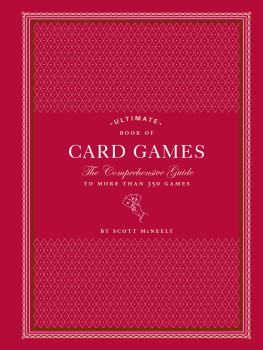


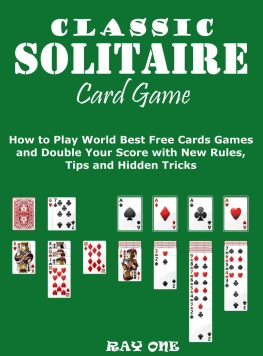
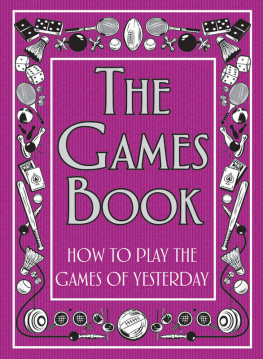

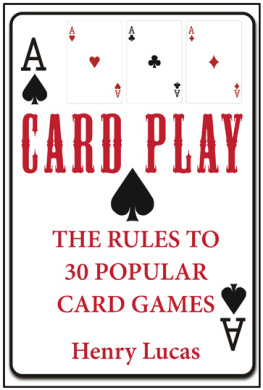
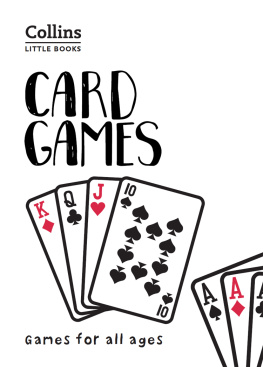



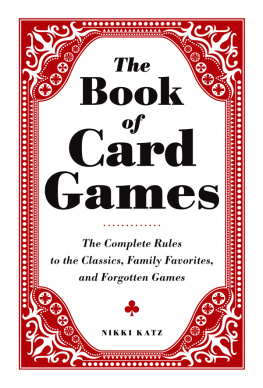


 SUITS & RANKS A standard deck has fifty-two cards, divided equally into four suits called hearts (of hearts), spades (of spades), diamonds (of diamonds), and clubs (of clubs). The two jokers are not typically used. In each suit there are thirteen card rankings or ranks, from 2 to 10, plus a jack, queen, king, and ace. In most games, 2 is the lowest in rank, ace the highest (although in many games the ace also can be played as the lowest card, as in 5-4-3-2-A). Some games have their own peculiar ranking systemsfor example, when 2s through 6s are removed from the deck, or when jacks rank higher than kings. Those ranking variances are outlined in the rules of play that are given for each game.
SUITS & RANKS A standard deck has fifty-two cards, divided equally into four suits called hearts (of hearts), spades (of spades), diamonds (of diamonds), and clubs (of clubs). The two jokers are not typically used. In each suit there are thirteen card rankings or ranks, from 2 to 10, plus a jack, queen, king, and ace. In most games, 2 is the lowest in rank, ace the highest (although in many games the ace also can be played as the lowest card, as in 5-4-3-2-A). Some games have their own peculiar ranking systemsfor example, when 2s through 6s are removed from the deck, or when jacks rank higher than kings. Those ranking variances are outlined in the rules of play that are given for each game.